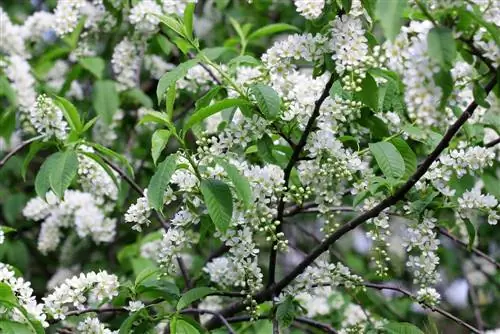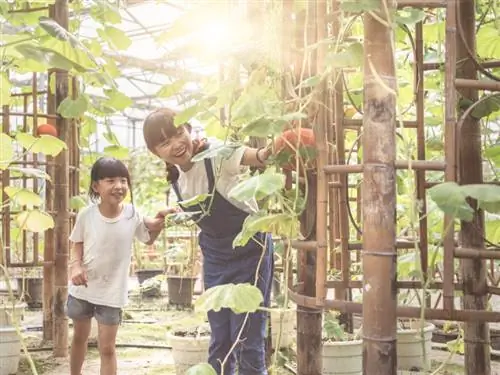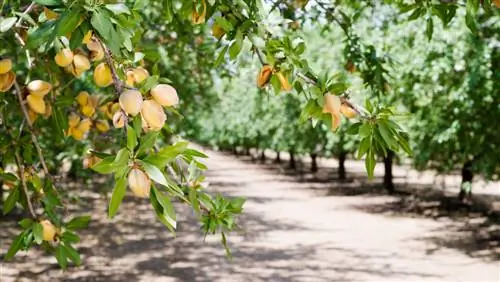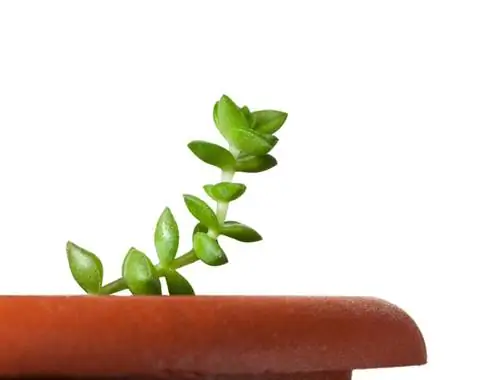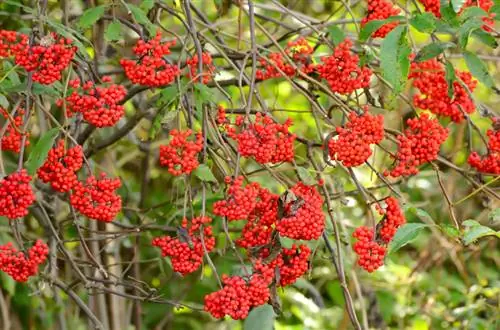- Author admin [email protected].
- Public 2023-12-16 16:46.
- Last modified 2025-06-01 06:02.
The bird cherry celebrates spring with a fairytale-like, white veil of flowers. In late summer, promising fruits beckon. A feast for hungry insects and distressed birds. Behind this picturesque setting, the stately wild fruit tree hides a dark secret that smells of bitter almonds. Should you enhance your natural garden with wild fruit trees or not? A green decision-making aid for hobby gardeners as to whether the bird cherry fits into the ecological garden concept with tips on proper planting and care.
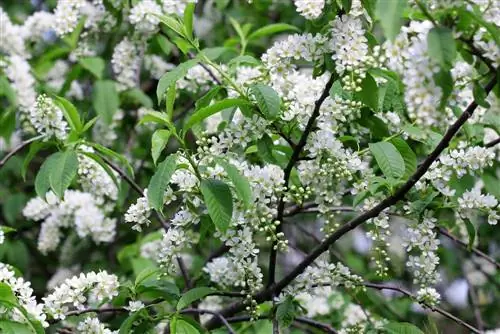
What characterizes the bird cherry?
The bird cherry (Prunus padus) is a deciduous tree that impresses with white flower clusters and edible fruits. Despite being partially toxic, it is an attractive addition to natural gardens, provides food for insects and birds and produces beautiful autumn color.
Profile
- Scientific name: Prunus padus
- Family: Rosaceae
- Growth type: deciduous shrub, small tree
- Growth height: 600 - 1500 cm
- Leaf: dark green, yellow-red autumn color
- Flowering period: April to June
- Flower: white grapes
- Fruit: Drupes
- Toxicity: partially toxic
- Winter hardiness: hardy
- Diseases and pests: lace drought, web moth
- Use: natural garden, ornamental tree, hedge
Fruit
During the lavish spring blooms, bees, hoverflies and butterflies take care of pollination. There is a lot to do for the busy insects, because a bird cherry shines with countless, 10 to 20 cm long, overhanging, 12 to 30-flowered clusters. As a reward, the pollinators are attracted to a sip of nectar in the center of each flower. Each pollinated flower turns into an edible drupe by late summer. These properties characterize the fruit of a bird cherry:
- Color: light red, black when fully ripe
- Size: pea size
- Shape: spherical
- Weight: 1.3 to 2.1 g
- Flesh: tart-bitter, edible, non-toxic
- Stone core: pointed, reticulated-pitty, poisonous
Video: A close look at edible stone fruits
Leaf
Shortly before the flowering period begins, the native bird cherry puts on its leafy coat. As the year progresses, the foliage undergoes a color change until it falls off in winter. You can recognize a leaf by these features:
- Colour: top matt dark green, bottom grey-green, yellow-red autumn color
- Size: 6 to 15 cm long
- Shape: obovate to elliptically pointed, petiolate, finely serrated leaf edge
- Special properties: important food plant for endangered butterfly species, such as black pepper butterflies and brimstone butterflies
- Gardening utility: quick decomposition, good humus formation, ideal addition to compost
The American bird cherry (Prunus serotina), which migrated to Central Europe, has 4 to 12 cm long, oblong-ovoid to oblong-lanceolate leaves with a dark green, shiny top and light green underside. Furthermore, the edge of the leaf is more distinctively toothed than on the leaf of a Prunus padus.
Toxicity
The bird cherry is extremely fickle when it comes to its toxic content. Some parts of the plant are permeated with toxins that are intended to keep predators at a distance. Other areas range from non-toxic to edible. The following table gives the details:
- Poisonous: bark, wood, roots, leaves, seeds, stone core,
- Non-toxic: flowers, pulp
- Edible: stone fruit without stone (juiced, prepared into puree, jam, distillate)
Poisonous plant parts primarily contain hydrogen cyanide, which can be recognized by the telltale bitter almond scent. The unpleasant smell is most noticeable when you sniff the bark or rub a leaf between your fingers. According to reputable sources, bird cherry has no healing effect (see botany.de). Traditional recipes report that a tea made from the bark promises relief from coughs, rheumatism, eye problems, asthma, gout and high blood pressure. It is not known whether consumers have to suffer nausea, vomiting and cramps for consuming bird cherry tea.
Usage
The bird cherry has all the valuable properties that hobby gardeners want from a tree for the natural garden. The opulent blossom festival with picturesque overhanging grapes, followed by furious autumn colors, is a source of inspiration for creative uses. Bee-friendly shell flowers, edible stone fruits and rapid growth to lofty heights round off the decorative and practical value. The following table provides an insight:
| Natural Garden | ornamental garden |
|---|---|
| Bee Pasture | Solitaire in the lawn |
| Bird food plant | House tree |
| Wild fruit bush | Privacy hedge |
In spring, a sea of flower clusters attracts bees, bumblebees, hoverflies and butterflies to the nectar-rich buffet. For birds, the table is set with nutritious berries in late summer. Now hobby gardeners have to hurry up to get their hands on some of the stone fruits as an ingredient for tart-fruity jam, bitter-sweet syrup or home-style wild fruit vinegar. As a romantic solitary shrub or house tree for the front garden, the bird cherry is an ornament. A privacy hedge made of Prunus padus protects privacy as a flowering bulwark against prying eyes.
The wood of the bird cherry
Under its inconspicuous, gray bark, the bird cherry hides a noble wood with valuable properties. Warm colors, a soft, elastic consistency, low weight and the best workmanship are what characterize bird cherry wood. The following table gives the details:
- Sapwood: whitish to yellowish, often tinged with reddish brown
- Heartwood: pale reddish yellow to light reddish brown, darkens
- Texture: soft, elastic, scattered porosity, fissile, highly flammable
Skilled DIY enthusiasts and experienced carpenters know how to use these advantages for the production of musical instruments, walking sticks, individual pieces of furniture and veneers. There are complaints about an intrusive smell and the toxic content. Due to poor weather resistance, rubber veins may occur. Logs grown in Central Europe are of secondary importance for the wood industry. In the USA, bird cherry wood is one of the most sought-after woods for making furniture.
Excursus
Growth rocket with invasive tendencies
The bird cherry scores with an annual growth of up to 70 centimeters. With this record-breaking speed, the rose family is on a par with the butterfly bush (Buddleja davidii) and other growth rockets. With this breathtaking growth, the bird cherry bush has earned the reputation of a neophyte. Planting with a root barrier and regular cutting keep the invasive spread under control.
Planting bird cherry correctly - instructions
The best time to plant a bird cherry as an inexpensive root product is in autumn. You can plant a young shrub in a container all year round as long as the soil is not frozen or dry. With careful choice of location and expert planting technique, you can set the course for rapid rooting. How to plant a bird cherry correctly:
Select location
The black cherry colonizes the riparian forests from Europe to Asia. In sunny, dry Mediterranean regions and on the limestone-rich Balkan islands, however, the wild fruit tree is a rare guest. This distribution provides important information about the location qualities that Prunus padus desires in the hobby garden:
- Sunny to partially shaded location
- Fresh, moist, nutrient-rich soil, well-drained
- Preferably neutral to slightly acidic pH value around 6
- Exclusion criteria: waterlogged, boggy, calcareous and extremely dry locations
Prepare location
Good soil preparation is recommended for the he althy growth of a freshly planted bird cherry. Rake the intended planting site several times. Take this opportunity to remove weeds and old roots. Now distribute 3 to 5 liters of ripe, sifted compost per square meter and rake in the organic starter fertilizer superficially.
Planting bird cherry
While you are preparing the soil, please place the roots of a young bird cherry in a bucket of water. Soaked root strands are less susceptible to drought stress, one of the most common causes of young tree failure in the first few months. This is how you plant the wild fruit tree correctly:
- Dig a planting pit twice the size of the root ball
- Enrich the excavation by one third with compost and horn shavings
- Line the pit with a root barrier
- Place the water-soaked root ball in the middle of the planting hole
- Drive the support post into the ground and connect it to the central shoot
- Fill up the pit, press down the soil and slurry it in
- Mulch the root disc with leaves, bark mulch or compost
One plant cutting is only required for a bird cherry as a root product. Before planting, cut off any broken roots. To ensure dense branching, shorten all side shoots by a third after planting. Please do not trim the supporting central shoot. If you have allocated space for bird cherries in a hedge, the recommended planting distance is 50 centimeters or two trees per linear meter.
Care for bird cherry - tips for hobby gardeners
Caring for a bird cherry is characterized by high water and nutrient requirements. Regular cutting prevents unwanted spread. Monilia tip drought causes the wood to wilt miserably. If the web moth is infested, there is a risk of baldness. The uncomplicated care program at a glance:
Pouring
The bird cherry is a very thirsty tree. Regular watering in dry conditions covers the high water consumption. If the soil under the bush feels dry, watering is necessary. Because rain can rarely penetrate the dense canopy, water even on rainy days. In midsummer, water the large shrub thoroughly in the early morning or late evening. Preferably use collected rainwater or stale, low-lime tap water.
Fertilize
Organic fertilizer gives a bird cherry the necessary growth energy. The nutrient reserves from soil preparation and starter fertilization are quickly used up. Replenishment is provided by a generous portion of compost soil in March and June with 3 to 5 liters per square meter. Rake the ideally sifted compost into the surface, as Prunus padus is a shallow rooter. To ensure that the nutrients are absorbed quickly, please water again.
Cutting
Pruning care is aimed at curbing growth, promoting a light-flooded crown and giving your bird cherry an attractive shape. Expert pruning stimulates growth, revitalizes flowering and prevents diseases. This is how you cut a bird cherry in an exemplary manner:
- Best time: February in frost-free, dry weather
- Alternative timing: end of June
- First clear out all dead wood
- Remove criss-cross and vertical branches
- Cut back heavily overhanging, too long shoots by a third or more
- Place scissors 3 to 5 mm away from a bud or a sleeping eye
- Important: Do not leave long stubs standing as potential entry points for fungal spores and other pathogens
If the topiary is limited to this year's growth, cut the bush or crown immediately after flowering. With this appointment you promote the abundance of flowers because Prunus padus blooms on annual wood. The bird cherry can form numerous runners and spread throughout the garden this way. Cut off root suckers where they branch off from a main root. Dispose of clippings with seeds, fruits or pieces of roots in organic waste or the household waste bin. Leafy, non-flowering, he althy shoots can go into the compost heap.
Fighting Prunus top drought
As part of the multifaceted Prunus genus, the bird cherry is not spared from typical diseases. An infestation with the fungal infection Monilia laxa, also known as Prunus tip drought, is common. Botanically related fellow sufferers are apples, pears, cherries, plums and morello cherries. Home remedies and fungicides are a losing battle in the fight against the disease. There is still hope for healing. How to combat top drought on a bird cherry:
- Symptoms: wilted flowers and leaves, whitish-brown fungal turf on dying shoot tips, gum flow
- Control: cut infected branches back 15 cm into he althy wood
- Prevention: annual thinning cut, remove fruit mummies, dispose of infected cuttings in household waste
Web moth - fight it or sit it out?
Much to the chagrin of hobby gardeners, a voracious pest has specialized in the bird cherry. The yellow-black caterpillars of the black cherry moth (Yponomeuta evonymellus) are insatiable in their greed and eat the wood bare. The end of the song is a completely wrapped, leafless skeleton that shimmers eerily in the sunlight. Combat is not necessary. The following brief insight into the life cycle of spider moths and the reaction of a bird cherry explains why this is so:
In spring, the overwintered caterpillars emerge from their pupae and eat the young leaves. At the same time, the pests produce a dense, silvery-white web to protect themselves from parasites and moisture. The insatiable larvae live, eat and pupate under this protective tissue. In mid/late June, adult moths emerge and do not eat, meaning that the damage to the leaves comes to an end. Just two weeks later, the long-suffering bird cherry sprouts again. The only downer is the failure of this year's wild fruit harvest because the pests also attack the flower clusters.
Popular varieties
The original species, early-flowering bird cherry (Prunus padus), was the inspiration for decorative varieties with different growth forms. In contrast, the late-flowering bird cherry (Prunus serotina) is currently without any varieties in Central Europe.
- Pyramid bird cherry 'Le Thoureil': Slender, conical shrub, 6 to 8 m high, pure white, overhanging flower clusters from April.
- Columnar bird cherry 'Obelisk': Columnar-shaped tree, 6 to 10 m high, blooms profusely from April to June.
- Butterfly cherry 'Watereri': mighty bird cherry, 8 to 12 m high, 6 to 8 m wide, flowering period from April to June.
- Late-flowering bird cherry: Flowering period from May to June, edible mini cherries in late summer, height 5 to 8 m.
- American bird cherry: Synonym for late-flowering bird cherry (Prunus serotina).
FAQ
Can you make jam from the fruits of a black cherry?
If you don't mind the tart, bitter taste of bird cherries, you can make jam or jelly from the stone fruits. It is important to note that you juice the fruits beforehand because the seeds contain toxic hydrogen cyanide. You can conjure up a tasty wild fruit jelly in no time using 1.7 liters of bird cherry juice, 1 kg of preserving sugar (2:1), 2 packets of vanilla sugar and 1 teaspoon of citric acid.
Is the bird cherry suitable as a hedge plant?
The bird cherry should not be missing in a mixed, free-growing wild fruit hedge. Especially in gardens with moist, nutrient-rich soil, the native Prunus padus impresses with a sea of flowers in spring and nutritious berries in autumn. Planted as a hedge, the native growth rockets quickly transform into a dense network of branches in which feathered and winged garden creatures can easily hide. Combine the bird cherry with blackthorn (Prunus spinosa), black elderberry (Sambucus nigra) and cornelian cherry (Cornus mas) at the ideal planting distance of 50 centimeters.
Is there a risk of confusion between bird cherries and other trees?
The bird cherry should be confused with the buckthorn (Rhamnus frangula). Both wild fruit bushes have gray bark and give off an unpleasant smell. Furthermore, in both types of trees the sapwood is yellowish-white and the heartwood is reddish. There is also a risk of confusion with regard to the name. The early-blooming bird cherry (Prunus padus) is popularly known as service cherry or serviceberry, which sounds similar to the serviceberry species serviceberry (Sorbus torminalis). Last but not least, the native bird cherry and the American bird cherry look very similar.
What calorific value does the wood of a bird cherry have?
The calorific value of the air-dried wood of a Prunus padus is 19.1 MJ/kg. This corresponds to a calorific value of 4.0 kWh/kg. This means that the wood of a bird cherry is on a par with maple, birch, plane tree or elm. Please note that these values refer to dried wood. As forest-fresh wood, bird cherry only has a calorific value of 6.8 MJ/kg and a calorific value of 1.9 kWh/kg.

